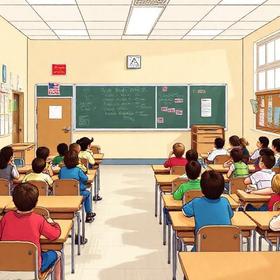If you live in the United States you cannot help but be aware of the gender gap. In the professional world, men are paid more than women and women often do not receive the same opportunities as their male counterparts. But how does the gender gap manifest in schools, especially public schools?
The sad truth of the matter is that low-income students often do not receive the same quality of instruction or educational opportunities as upper-class students, but even within the lower-income class there are disparities between boys and girls. There is a great deal of evidence to suggest that low-income boys are more disadvantaged than low-income girls and they may have a harder time breaking out of the broken public school system to make a better life for themselves.
Public School Statistics in the United States
According to the Southern Education Foundation (SEF), low-income students have become the majority in children attending public schools. A survey conducted by the National Center for Education Statistics (NCES) showed that 51% of the students in the U.S. public school system came from low-income families in 2013. In some states, the percentage is even higher. For example, in Mississippi the number of low-income children in public schools is 71% - that is nearly three out of four students.
Not only are these statistics troubling in terms of educational disparity, but the SEF comments that “No longer can we consider the problems and needs of low-income students simply a matter of fairness… their success or failure in the public schools will determine the entire body of human capital and educational potential that the nation will possess in the future”. If the majority of the students in public schools are limited by their low-income status, what does that say for the future of our nation?
This TEDx Talk explores the topic of the brain on poverty.
Educational Performance in Low-Income Students
In order to understand the importance of the statistics mentioned earlier, you need to learn why economic disadvantage correlates to educational disadvantage and what that means for low-income students around the nation. According to Alexandria Walton Radford, research director at RTI International and author of the book Top Student, Top School? How Social Class Shapes Where Valedictorians Go to College, students that come from poor families have a much lower likelihood of attending a top-ranked college or university. Radford performed a national study which revealed that just 3% of students at 146 of the most selective private and public colleges in the nation came from the lowest socioeconomic quartile. Even more shocking, more freshmen at prestigious universities like the University of Michigan came from families with an annual income over $200,000 than from families with an annual income below $53,000.
To better understand Radford’s work, consider that the students she studied were all highly qualified, all other class markers and income factors aside. If only 3% of the most highly qualified low-income students made it into good colleges and universities, what happens to the rest of them? According to Radford, an overwhelming majority of low-income students chose to not even apply to college or university after finishing public school.
There are many factors that may contribute to this decision including the following:
- Students from low-income areas may be less educationally prepared for secondary education at a top-rated college or university.
- Many low-income students are psychologically blocked from applying because they assume that they will not be able to afford their schooling.
- A high number of students are not even taught how the application process works so they do not realize that financial assistance exists for needy students and they don’t know how to apply for it.
- Low-income students are not raised with the same expectation as higher-income students that secondary education will automatically follow grade school.
It is sad but true that low-income students simply do not receive the same preparation as upper-class students when it comes to college admissions and applications. It is not entirely a matter of education, either – in many cases the teachers and school administrators in low-income areas do not understand the admissions process themselves so they are ill-equipped to help their students. Financial assistance does exist for needy students, but in communities where few people go on to attend anything other than the local community college, many students simply don’t know about it.
This video reports on being poor in the world's richest country.
Low-Income Boys versus Low-Income Boys
It should be obvious to you by now that a great disparity exists between low-income and high-income families in terms of educational opportunities and preparation for secondary education. But you may not realize that the disparity goes even deeper than that – low-income boys tend to be more disadvantaged than low-income girls and it can have a serious impact on their future. According to The Washington Post, boys have been falling behind girls in school since the 1950s. Women may not get paid as much as men in the business world, but they have a higher rate of passing high school and obtaining a college degree than men. There are several theories as to why this might be the case. Perhaps girls receive more encouragement to succeed in school or perhaps they mature more quickly than boys. But how does the income come into play in terms of this gender gap?
According to an article published in The New York Times, not only are boys graduating from high school and college at lower rates than girls but they have a greater tendency to get into trouble which can hurt them when they start looking for jobs. New research suggests that one potential reason for this disparity is that boys might simply be more sensitive to disadvantages than girls. Disadvantages like growing up in a poor family, living in a bad neighborhood, or not having a father figure can take a greater toll on boys than it does on girls. As they enter the educational system, the gap gets wider as they have a greater tendency to skip school, be suspended, perform poorly on standardized tests, commit crimes or develop behavior problems.
It is also important to note that boys are taught not to show vulnerability – they are told to be a man. In many cases, this kind of emotional suppression leads to aggressive behaviors and outbursts which can correlate to serious crimes and serious punishment. It may also correlate with a lesser tendency to ask for help – the kind of help that could lead to better education and more educational opportunities. As boys and girls work their way through the public school system, boys continue to fall more and more behind which sets them up for failure when it comes time for college applications. A staggering number of low-income boys do not graduate high school at all, let alone apply for or attend college. The family situation has a higher impact on the future of a child than many people realize and, unfortunately, it is not something that the child can control.
The importance of quality education is undeniable when it comes to entering the job market with a good chance of success. Unfortunately, many students (perhaps even a majority) fail to receive the quality of education and support they need to even make it through the public school system. Serious educational reform may be needed to close the gender gap, but that is not something that can happen overnight.
Questions? Contact us on Facebook. @publicschoolreview














